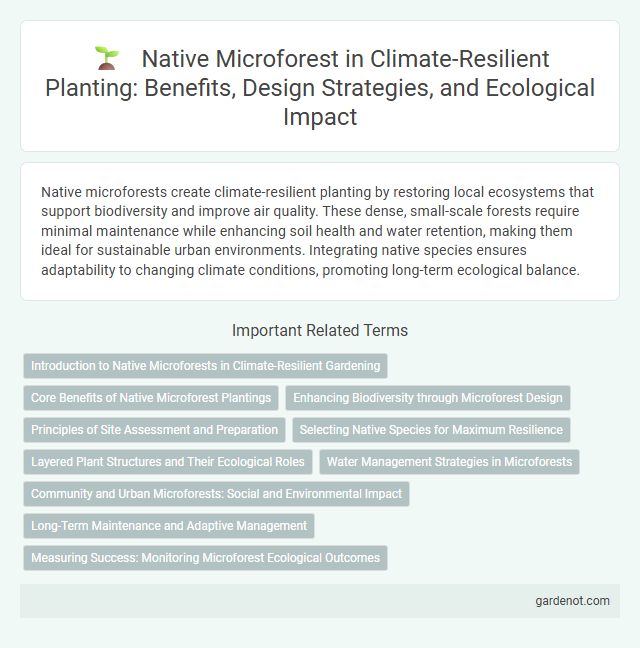Native microforests create climate-resilient planting by restoring local ecosystems that support biodiversity and improve air quality. These dense, small-scale forests require minimal maintenance while enhancing soil health and water retention, making them ideal for sustainable urban environments. Integrating native species ensures adaptability to changing climate conditions, promoting long-term ecological balance.
Introduction to Native Microforests in Climate-Resilient Gardening
Native microforests leverage dense clusters of indigenous plant species to enhance biodiversity and improve ecosystem resilience against climate change impacts. These compact, multilayered plantings optimize carbon sequestration, soil health, and water retention by mimicking natural forest structures in urban and suburban gardens. Incorporating native microforests supports local wildlife habitats and bolsters climate-resilient gardening practices through sustainable, low-maintenance vegetation.
Core Benefits of Native Microforest Plantings
Native microforest plantings enhance biodiversity by creating habitats that support local wildlife and pollinators, promoting ecological balance. These microforests improve soil health and water retention, which contributes to climate resilience by reducing erosion and mitigating urban heat effects. Incorporating native species increases carbon sequestration effectively, helping combat climate change while preserving regional genetic diversity.
Enhancing Biodiversity through Microforest Design
Native microforests enhance biodiversity by creating dense, layered habitats that support diverse flora and fauna within urban and degraded landscapes. Strategic microforest design incorporates native species with varied growth patterns and soil adaptations, promoting ecosystem resilience and improving air quality. These compact green spaces foster pollinator networks, increase carbon sequestration, and restore local ecological balance.
Principles of Site Assessment and Preparation
Effective site assessment for native microforest planting involves detailed analysis of soil composition, moisture levels, and existing vegetation to ensure optimal tree species selection and growth conditions. Preparation activities prioritize removing invasive species, enhancing soil health through organic amendments, and creating microhabitats that support biodiversity and improve resilience against climate stressors. These principles enhance the survival rate of native plants and contribute to a sustainable, climate-resilient microforest ecosystem.
Selecting Native Species for Maximum Resilience
Selecting native species for a native microforest ensures maximum resilience by harnessing plants adapted to local climate conditions and soil types. These species contribute to biodiversity, improve ecosystem stability, and enhance carbon sequestration while reducing water usage and maintenance needs. Emphasizing diverse native flora supports resistance to pests, diseases, and extreme weather, fostering a sustainable, climate-resilient microforest environment.
Layered Plant Structures and Their Ecological Roles
Native microforests employ layered plant structures, including canopy trees, understory shrubs, and groundcover species, which enhance biodiversity and improve habitat complexity. These layers facilitate efficient nutrient cycling and water retention, increasing ecosystem resilience to climate stressors. By mimicking natural forest stratification, native microforests promote microclimate regulation and support pollinators, soil organisms, and wildlife essential for ecological balance.
Water Management Strategies in Microforests
Native microforests enhance water management through deep-rooted plant species that improve soil infiltration and reduce surface runoff. These microforests mimic natural forest structures, promoting efficient water absorption and storage, which sustains soil moisture during dry periods. Integrating native vegetation supports groundwater recharge and diminishes flood risks, contributing to climate resilience.
Community and Urban Microforests: Social and Environmental Impact
Native microforests enhance urban biodiversity by restoring local ecosystems and providing critical habitat for pollinators and wildlife. These community-led green spaces improve air quality, reduce urban heat islands, and foster social cohesion by creating shared environments for education and recreation. Implementing native species in microforests supports climate resilience by increasing carbon sequestration and promoting adaptive ecological networks within city landscapes.
Long-Term Maintenance and Adaptive Management
Native microforests require long-term maintenance strategies focused on monitoring tree health, controlling invasive species, and ensuring soil fertility to enhance climate resilience. Adaptive management practices involve periodic assessment of ecosystem responses to environmental changes, allowing for adjustments in species selection and planting density. Integrating indigenous knowledge with scientific monitoring helps optimize restoration outcomes and supports sustainable biodiversity in variable climate conditions.
Measuring Success: Monitoring Microforest Ecological Outcomes
Measuring success in native microforest planting involves systematically monitoring key ecological outcomes such as biodiversity levels, soil health, and carbon sequestration rates. Tracking species diversity through regular surveys helps assess habitat restoration effectiveness, while soil nutrient tests indicate improvements in ecosystem function. Remote sensing and ground-based data collection combined provide comprehensive insights into microforest resilience and growth over time.
Native microforest Infographic

 gardenot.com
gardenot.com